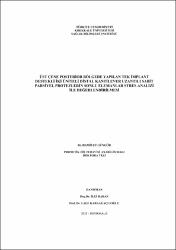| dc.contributor.advisor | Baran, İlgi | |
| dc.contributor.advisor | Karaağaçlıoğlu, Lale | |
| dc.contributor.author | Güngör, Hamiyet | |
| dc.date.accessioned | 2021-01-16T18:54:49Z | |
| dc.date.available | 2021-01-16T18:54:49Z | |
| dc.date.issued | 2015 | |
| dc.identifier.uri | | |
| dc.identifier.uri | https://hdl.handle.net/20.500.12587/14261 | |
| dc.description | YÖK Tez ID: 414977 | en_US |
| dc.description.abstract | Üst çene posterior bölgede oluşan erken diş kayıpları sonucu implant destekli sabit protezler veya hareketli bölümlü protezler tedavi seçenekleri arasında yer alırlar. Sabit protez kullanmak isteyen hastalarda bazı durumlarda kemik yapı ve anatomik oluşumlar implantların istenilen yere yerleştirilmesine izin vermeyebilir. Böyle durumlarda kemik augmentasyonu veya sinüs tabanını yükseltme işlemi gibi seçenekler düşünülebilir ancak hem maliyet hem zaman hem de hastanın birkaç kez cerrahi işlem geçirmesi implant destekli kantilever uzantılı sabit protez kullanımını akla getirmektedir. Bu protezler hastayı hem estetik hem de fonksiyon olarak memnun edecektir. Bu tür bir protez planlarken mevcut kemiğe en uygun çap ve boydaki implantı seçmek gerekmektedir. Kemik rezorbsiyonu nedeni ile kron/implant oranının artacağını da gözardı edilmemelidir. Çalışmamızda sonlu eleman stres analiz yöntemi kullanılarak farklı çap (3,3-4,1mm) ve boydaki (10-12mm) ITI marka implant üzerine yapılan iki üniteli distal kantilever uzantılı sabit protez için 3 farklı kron/implant oranı (1/1, 1,5/1,2/1) modellenmiştir. Her bir kron/implant oranı için beş farklı kantilever uzantı (5,6,7,8 ve 9mm) kullanılmıştır. Modellerde her bir krona 300 N.luk kuvvet dik ve oblik olarak uygulanmış; implantta,kemikte ve metal alt yapıda oluşan stresler değerlendirilmiştir. Çalışmamızın sonucunda 3,3 mm çapındaki implantın kantilever uzantılı sabit protezler için üst çene posterior bölgede kullanımının uygun olmadığı tespit edilmiştir. Oluşturulan her model için kron/implant ve distal kantilever uzantısının artmasının stresleri artırdığı sonucuna varılmıştır. 4,1 mm çapında implant kullanımında ise kantilever uzantısının maksimum 9 mm olması bile implantta oluşturduğu stresler açısından kabul edilebilir bulunmuştur. | en_US |
| dc.description.abstract | Implant supported fixed partial dentures and removable dentures can be the treatment options when early tooth loss is occured in the posterior region of the maxilla. In some cases, patients who wants to use fixed partial denture, bone structure and anatomical structures don't allow the insertion of implant at the preferred region. In such cases, sinus augmentation and bone grafting can be preferred but treatment cost and time wasting must be considered. Because of these reasons implant supported fixed partial denture with cantilever extension can be the ideal treatment choise. This kind of prosthesis will please the patients both estetically and functionally. While selecting the implant size optimal implant diameter and implant height must be selected according to the existing bone. It mustn't be forgotten that crown/implant ratio will increase in consequence of bone resorbsion. In our study we modeled the implants with different diameter (3,3mm and 4,1 mm) and different height (10mm and 12mm) using finite element analysis methods. The crown/ implant ratios were 1/1, 1,5/1, 2/1. For each crown/ implant ratio; the distal cantilever lenghts were 5,6,7,8 and 9 mm. 300 N force was applied to the each crown and the stress values were evaluated at alveolar bone, implant and metal substructure. As a conlusıon when the implant diameter is 3,3 mm; implant mustn't be used for supporting fixed partial denture with distal cantilever in the posterior region of the maxilla. Increasing the crown implant ratio and cantilever length will increase the stress in each finite elelemt models. It was also found that if the implant diameter is 4,1 mm, it can be used with all cantilever legth at the posterior region of the maxilla. | en_US |
| dc.language.iso | tur | en_US |
| dc.publisher | Kırıkkale Üniversitesi | en_US |
| dc.rights | info:eu-repo/semantics/openAccess | en_US |
| dc.subject | Diş Hekimliği | en_US |
| dc.subject | Dentistry | en_US |
| dc.subject | | en_US |
| dc.subject | | en_US |
| dc.subject | | en_US |
| dc.subject | | en_US |
| dc.subject | | en_US |
| dc.subject | | en_US |
| dc.subject | | en_US |
| dc.subject | | en_US |
| dc.subject | | en_US |
| dc.subject | | en_US |
| dc.subject | | en_US |
| dc.title | Üst çene posterior bölgede yapılan tek implant destekli iki üniteli distal uzantılı sabit parsiyel protezlerin sonlu eleman analizi ile değerlendirilmesi | en_US |
| dc.title.alternative | Finite element analysis of stress distribution around one implant-supported two unit fixed cantilever prosthesis in the posterior maxilla | en_US |
| dc.type | doctoralThesis | en_US |
| dc.contributor.department | KKÜ, Sağlık Bilimleri Enstitüsü, Protetik Diş Tedavisi Anabilim Dalı | en_US |
| dc.identifier.startpage | 1 | en_US |
| dc.identifier.endpage | 153 | en_US |
| dc.relation.publicationcategory | Tez | en_US |
















